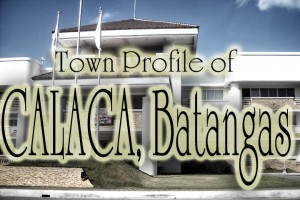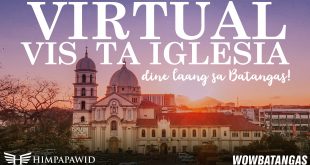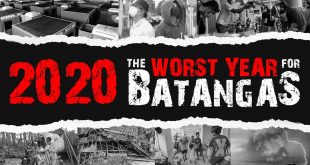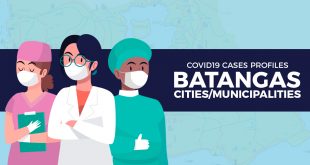Visit the Calaca page for all information on Calaca.
Calaca, a first class municipality in Batangas, traces its roots from way before the Spanish occupation. And there are also two versions as to why is Calaca is called such.
The first version was about the story of ten Datus who escaped from Borneo and reached the islands of Panay in the Philippines. Out of the ten Datus, two of them continued their journey until they reached the southern portion of Luzon.
One out of the two groups, led by Datu Dumangsil, resided at the mouth of Pansipit River. This datu and his troops stayed in the area where Taal is now located. The “Lakan” or “Laka” or tribe settled in this area. The Datu as a part of his territory then declared the location of Calaca.
There were times where tribesmen would go to the area to hunt. Every time they see fellow tribesmen, they always exchanged greetings such as “Kalaka” and “Katribu”, meaning fellow tribesmen. The greetings to each other remained and eventually became the official name of Calaca.
The second version were that of the Spaniards who passed by a group of native people who were building a Nipa hut. The Spaniards asked for the name of the area to the natives. Because the natives cannot understand the Spaniards, the natives assumed that the Spaniards asked about what there were doing. So they answered, “Kalaka”, because they were installing the roof made out of “kalaka”. Laka is a bamboo splitted into two. The halves laid upside down cover the edges of the halves, which lay under the inner parts, which face each other.
ESTABLISHMENT OF THE TOWN
 Rufino Punungbayan, Cayetano Buhay, Januario Punungbayan, Valentin Capacia, Juan Sanggalang and Diego Inumerable pioneered the establishment of the Town. Don Rufino Punungbayan was the first Gobernadorcillo of the Municipality during the year 1835-1836.
Rufino Punungbayan, Cayetano Buhay, Januario Punungbayan, Valentin Capacia, Juan Sanggalang and Diego Inumerable pioneered the establishment of the Town. Don Rufino Punungbayan was the first Gobernadorcillo of the Municipality during the year 1835-1836.
Calaca is on the eastern portion of the present Poblacion, just on the other side of the Bolbok River. The house was made with “Kalaka” roofing. In he course of time, the barrio grew into thriving. However, the founders were worried of its location then, considering the topography of the surrounding vicinity, it being sandwich closely by the two ravines on both east and west sides. So, they looked for a better site. The present site being a white plane was finally selected to the site of the Poblacion.
Roads were laid out as what they are now, but were not given any name. The only one roading the back of the present church disappeared because no one cared to passed there. It was in the later part of the Spanish regime and early part of the American military rule when the streets were named mostly in honor of those who contributed and worked hard for the welfare of the town. They were named Vizconde. The assistant of Mr.Maclough was Sinforoso Ilagan. Years later, Filipinos were hired to teaches`. One of them was Manuel Agregado who was appointed as a teacher in 1905. Agregado later became Auditor-general of the Philippines. Luckily enough, the Second World War spared Calaca from considerable destruction although the town sampled the Japanese atrocities. The first Japanese soldiers arrived in Calaca in the middle of the January 1942. Several months later, they commandeered tillable lands and cotton September 1942. The Dai Nippon Bosok KK succeeded the Tokatu Cotton Company.
On or about December 30, 1941, USAFFE soldiers were deployed on the different parts of the town. He 41st. infantry division was strategitically stationed in Dela Paz st. along the western portion of the blank of Bolbok River. Fax hole was dug extending up north to Maugat from the corner of the old Highway, which is now part of the Rodriguez St. The 50 caliber machine guns were placed in the strategic positions in occupied area.
The 41st Infantry division left the municipality on December 21, 1941 for Bataan. Soon after the fall of Bataan on April 9, 1942, the underground movement was organized in Calaca. Many of the Calaqueños joined the organization. Secrets meeting were held in houses in the Poblacion to map out plans against the Japanese Imperial Forces.
Dr. Bernardo Macatangay, the Municipal Mayor at the time of the occupation of Calaca, was ordered to continue his term of peace, together with other municipal officials. Administration was then an exposure to construction and administrator was placed between two conflicts which; to side with other force meant death.
The guerillas of Calaca helped much in the expeditious liberation of the town. They helped in detecting the activities, spied their positions, their trenches, dugouts, strength, food supply and ammunitions.
The Japanese occupied Calaca from February 1942 to March 6, 1945, when the American Liberation Forces with some guerilla units entered the town.
The war did not cause much destruction on the lives and property of the people in Calaca. Most of those who died were soldiers who fought in Bataan and war prisoners who did not survive the death march.
Shortly after the establishment of the military government in the archipelago several months after the liberation, Calaca was included in the list of beneficiaries under the Philippine Relief and Rehabilitation Administration.
Food, Clothing, and other prime commodities were distributed among the town’s people. Gradually the condition of the town’s people returned to normal.
However, several years later, fear reigned once more in the hearts of natives. During the height of campaign of the government against dissidents in the central plain of Luzon, the Huk movement spread as far as the most remote barrios of Calaca. Time came when the barrio folk took up warms and fought the Hukbalahaps. So, one by one, they surrendered to the government forces, which in turn willingly granted considered outlaws, they were later on killed in action or liquidated by their own companions in consideration of a modest sum offered by the government. Hence, the Huk movement in Calaca was suppressed.
Last Updated: September 5, 2013
 WOWBatangas.com Your Source of Great News and Stories from the Province of Batangas, Philippines
WOWBatangas.com Your Source of Great News and Stories from the Province of Batangas, Philippines




